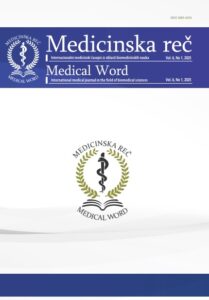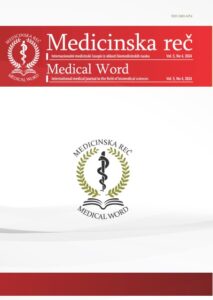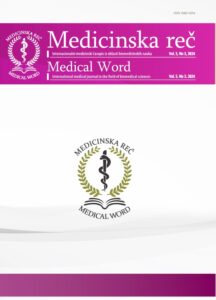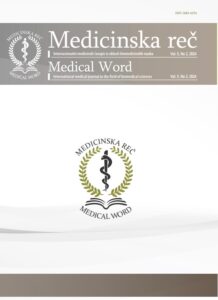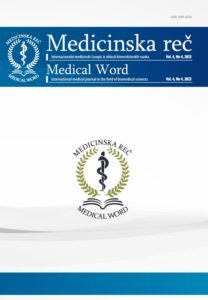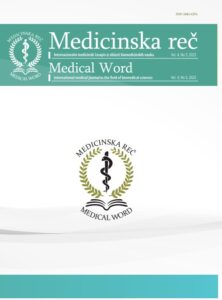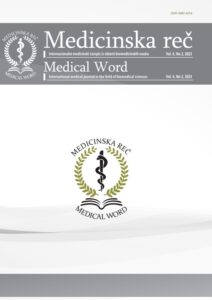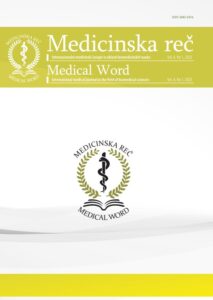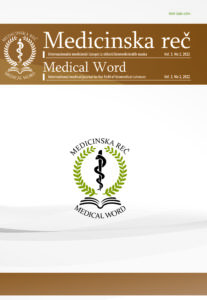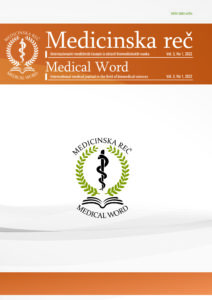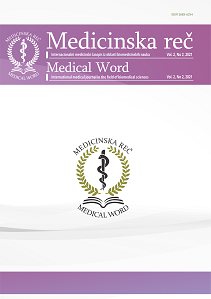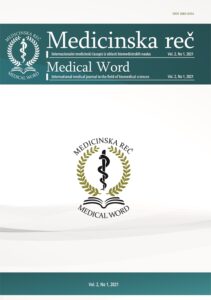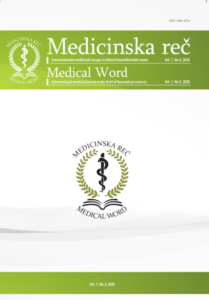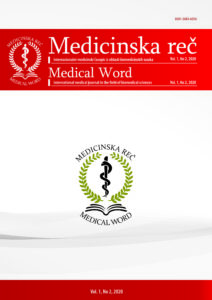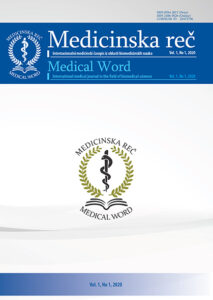Vazoaktivna terapija kod pacijenata sa senzorineuralnom hipoakuzijom
Dejan Rančić, Јоvan Todorović, Marija Mladenović
Med reč 2020; 1(1): 29–35
DOI: https://doi.org/10.5937/medrec2001029R
Apstrakt
Gubitak sluha predstavlja jedan od najčešćih zdrastvenih problema koji se manifestuje subjektivnim osećajem oslabljenog sluha, nemogućnošću slušanja u buci, povremenim ili stalnim osećajem zujanja (tinitusom). Može biti konduktivnog ili senzorineuralnog tipa (SNHL). Senzorineuralno oštećenje sluha nastaje zbog degeneracije kohlee, koja je odgovorna za transdukciju zvučnih stimulusa u nervni impuls.
Cilj rada je bio da se utvrde efekti primenjene vazoaktivne i hemokinetske terapije kod osoba sa senzorineuralnom hipoakuzijom koji su odbili ugrađivanje slušnih amplifikatora.
Pacijenti i metode: Retrospektivnom studijom je obuhvaćen 51 pacijent, kojima je u trogodišnjem periodu na Kliici za otorinolaringologiju KC Niš postavljena dijagnoza senzorineuralne nagluvosti. Bolesnici su klinički procenjivani na osnovu otoskopskog pregleda i nalaza tonalne audiometrije. Pacijenti su bili na terapiji pentoksifilinom, vitaminima B1 i B6, cinarizinom (stariji od 50 godina) i betahistinom (mlađi od 50 godina), 28 dana. Nakon terapije, koristeći tonalnu audiometriju, pratili smo frekvence od 125–8000 Hz i poboljšanja u decibelima. Kontrole su bile na 3 do 4 nedelje. Za analizu i obradu smo koristili najgori nalaz i najbolji odgovor.
Primenjena terapija je dovela do poboljšanja u svim frekvencama, a naročito u visokim (2–8 kHz) (p < 0.001). Subjektivne tegobe, poput zujanja u ušima su bile odsutne, ili su gubile na intenzitetu. Pacijenti su imali subjektivni osećaj bolje slušne funkcionalnosti (bolja komunikacija, bolji slušni doživljj okoline).
U našoj studiji smo pokazali da primena vazodilatatora i hemokinetika u lečenju SNHL kod bolesnika ima pozitivne efekte u svim frekvencama, pogotovo u visokim (2–8 kHz).
Ključne reči: senzorineuralna hipoakuzija, vazodilatatori, hemokinetici, tonalna audiometrija
Literatura
- LeMasurier M, Gillespie PG. Hair-cell mechanotransduction and cochlear amplification. Neuron 2005; 48: 403–15.
- Hibino H, Kurachi Y. Molecular and physiological bases of the K+ circulation in the mammalian inner ear. Physiology 2006; 21: 336–45.
- Guinan JJ Jr, Salt A, Cheatham MA. Progress in cochlear physiology after Bekesy. Hear Res 2012; 293: 12–20.
- Gates GA, Mills JH. Presbycusis. The Lancet 2005; 366: 1111–20.
- Ryals BM, Dooling RJ, Westbrook E, Dent ML, Mackenzie A, Larsen ON. Avian species differences in susceptibility to noise exposure. Hear Res 1999; 131: 71–88.
- White JA, Burgess BJ, Hall RD, Nadol JB. Pattern of degeneration of the spiral ganglion cell and its processes in the C57BL/6J mouse. Hear Res 2000; 141: 12–18.
- Linthicum FH Jr, Fayad JN. Spiral ganglion cell loss is unrelated to segmental cochlear sensory system degeneration in humans. Otol Neurotol 2009; 30(3): 418–22.
- Ohlemiller KK, Gagnon PM. Apical-to-basal gradients in age-related cochlear degeneration and their relationship to “primary” loss of cochlear neurons. J Comp Neurol 2004; 479: 103–16.
- Schuknecht HF, Gacek MR. Cochlear pathology in presbycusis. Ann. Otol Rhinol Laryngol 1993; 102: 1–16.
- Menardo J, Tang Y, Ladrech S, Lenoir M, Casas F, Michel C, et al. Oxidative stress, inflammation, and autophagic stress as the key mechanisms of premature age-related hearing loss in SAMP8 mouse Cochlea. Antioxid. Redox Signal 2012; 16: 263–74.
- Moser T, Predoehl F, Starr A. Review of hair cell synapse defects in sensorineural hearing impairment. Otol Neurotol 2013; 34: 995–1004.
- Starr A, Picton TW, Sininger Y, Hood LJ, Berlin CI. Auditory neuropathy. Brain 1996; 119(Pt 3): 741–53.
- Kraus N, Bradlow AR, Cheatham MA, Cunningham J, King CD, Koch DB, et al. Consequences of neural asynchrony: a case of auditory neuropathy. J. Assoc Res Otolaryngol 2000; 1: 33–45.
- Plontke S. Therapy of hearing disorders – conservative procedures. GMS Curr Top Otorhinolaryngol Head Neck Surg 2005; 4: Doc 01.
- Bond M, Mealing S, Anderson R, Elston J, Weiner G, Taylor RS, et al. The effectiveness and cost-effectiveness of cochlear implants for severe to profound deafness in children and adults: a systematic review and economic model. Health Techno Assess 2009; 13: 1–330.
- Merchant SN, Nadol JB. Schuknecht’s Pathology of the Ear. Shelton: People’s Medical Publishing House 2010; 942 p.
- Patuzzi R. Ion flow in stria vascularis and the production and regulation of cochlear endolymph and the endolymphatic potential. Hear Res 2011; 277: 4–19.
- Kikuchi T, Adams JC, Miyabe Y, So E, Kobayashi T. Potassium ion recycling pathway via gap junction systems in the mammalian cochlea and its interruption in hereditary nonsyndromic deafness. Med Electron Microsc 2000; 33: 51–6.
- Schütz M, Auth T, Gehrt A, Bosen F, Körber I, Strenzke N, et al. The connexin26 S17F mouse mutant represents a model for the human hereditary keratitis-ichthyosis-deafness syndrome. Hum Mol Genet 2011; 20: 28–39.
- Winkler J, Ramirez GA, Kuhn HG, Peterson DA, Day-Lollini PA, Stewart GR, et al. Reversible Schwann cell hyperplasia and sprouting of sensory and sympathetic neurites after intraventricular administration of nerve growth factor. Ann Neurol 1997; 41: 82–93.
- Williams LR. Hypophagia is induced by intracerebroventricular administration of nerve growth factor. Exp Neurol 1991; 113: 31–7.
- Eriksdotter Jonhagen M, Nordberg A, Amberla K, Backman L, Ebendal T, Meyerson B, et al. Intracerebroventricular infusion of nerve growth factor in three patients with Alzheimer’s disease. Dement. Geriatr Cogn Disord 1998; 9(5): 246–57.
- Lenarz T. Treatment of sudden deafness with the calcium antagonist nimodipine. Results of a comparative study. Laryngorhinootologie 1989; 68(11): 634-7.
- Evans P, Halliwell B. Free radicals and hearing: cause, consequence, and criteria. Ann N Y Acad Sci 1999; 884: 19-40.
- Kopke R, Allen KA, Henderson D, Hoffer M, Frenz D, Van de Water TR. A radical demise: Toxins and trauma share common pathways in hair cell death. Ann N Y Acad Sci 1999; 884: 171- 91.
- Sprem N, Branica S, Dawidowsky K. Vasodilator and vitamins in therapy of sensorineural hearing loss following war-related blast injury: retrospective study. Croat Med J 2001: 42(6): 646–9.
- McCabe BF. Autoimmune inner ear disease: therapy. Am J Otol 1989; 10: 196–7.
- Harris JP. Immunology of the inner ear: response of the inner ear to antigen challenge. Otolaryngol. Head Neck Surg 1983; 91: 18–32.
- Harris JP, Low NC, House WF. Contralateral hearing loss following inner ear injury: sympathetic cochleolabyrinthitis? Am J Otol 1985; 6: 371–7.
- Zhang W, Dai M, Fridberger A, Hassan A, Degagne J, Neng L, et al. Perivascular-resident macrophage-like melanocytes in the inner ear are essential for the integrity of the intrastrial fluid-blood barrier. Proc Natl Acad Sci USA 2012; 109: 10388–93.
- Hirose K, Discolo CM, Keasler JR, Ransohoff R. Mononuclear phagocytes migrate into the murine cochlea after acoustic trauma. J Comp Neurol 2005; 489: 180–94.
- Dai M, Shi X. Fibro-vascular coupling in the control of cochlear blood flow. PLoS ONE 2011; 6(6): e20652.
- Fujioka M, Kanzaki S, Okano HJ, Masuda M, Ogawa K, Okano H. Proinflammatory cytokines expression in noise-induced damaged cochlea. J Neurosci Res 2006; 83: 575–83.
- Fujioka M, Okamoto Y, Shinden S, Okano HJ, Okano H, Ogawa K, et al. Pharmacological inhibition of cochlear mitochondrial respiratory chain induces secondary inflammation in the lateral wall: a potential therapeutic target for sensorineural hearing loss. PLoS ONE 2014; 9(3): e90089.
- Wakabayashi K, Fujioka M, Kanzaki S, Okano HJ, Shibata S, Yamashita D, et al. Blockade of interleukin-6 signaling suppressed cochlear inflammatory response and improved hearing impairment in noise-damaged mice cochlea. Neurosci Res 2010; 66: 345–52.


